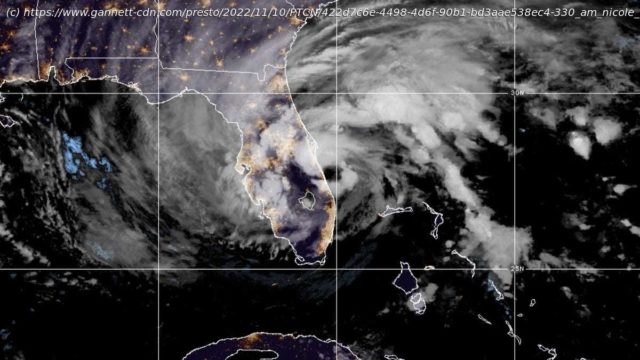See where Hurricane Nicole is, where it’s headed and how it may affect Florida.
We have made this article free to all readers in the interests of public safety. Please consider supporting local journalism with a digital subscription.
Hurricane Nichole made landfall just south of Vero Beach at 3 a.m., according to the National Hurricane Center.
Maximum sustained winds were estimated to be 75 mph.
Nicole is continuing to move west-northwest at 14 mph
An hour after landfall, Nicole weakened into a tropical storm, with maximum sustained winds of 70 mph.
The storm is bringing strong winds, dangerous storm surge and waves, and heavy rain over a large area of Florida.
Tropical-storm-force winds extend outward up to 450 miles from the center, especially to the north.
Webcams: See conditions at Florida beaches
Hurricane guide: See how you should prepare and what to do after a storm passes
Cone of uncertainty: See the latest graphic from the NHC
Satellite images: See latest satellite image from NOAA, for a clearer picture of the storm’s size
Here is the latest data on Tropical Storm Nicole pulled from the National Hurricane Center’s 4 a.m. advisory.
At 4 a.m., the center of Tropical Storm Nicole was located 25 miles northwest of Vero Beach.
Nicole is moving toward the west-northwest near 14 mph. A turn toward the northwest and north-northwest is expected later today and tonight, followed by an acceleration toward the north and north-northeast on Friday.
How big is Nicole?: Hurricane Nicole is a very large storm: At 970 miles wide, it’s bigger than Texas
Live updates: Hurricane Nicole makes landfall on Florida’s southeast coast
Nicole just not normal: ‘This is not your classic Florida hurricane:’ Why Hurricane Nicole is an ‘oddball’
On the forecast track, the center of Nicole will move across Central Florida this morning, possibly emerge over the far northeastern Gulf of Mexico this afternoon, and then move across the Florida Panhandle and Georgia tonight and on Friday.
Домой
United States
USA — mix Hurricane Nicole makes landfall just south of Vero Beach with sustained winds...






